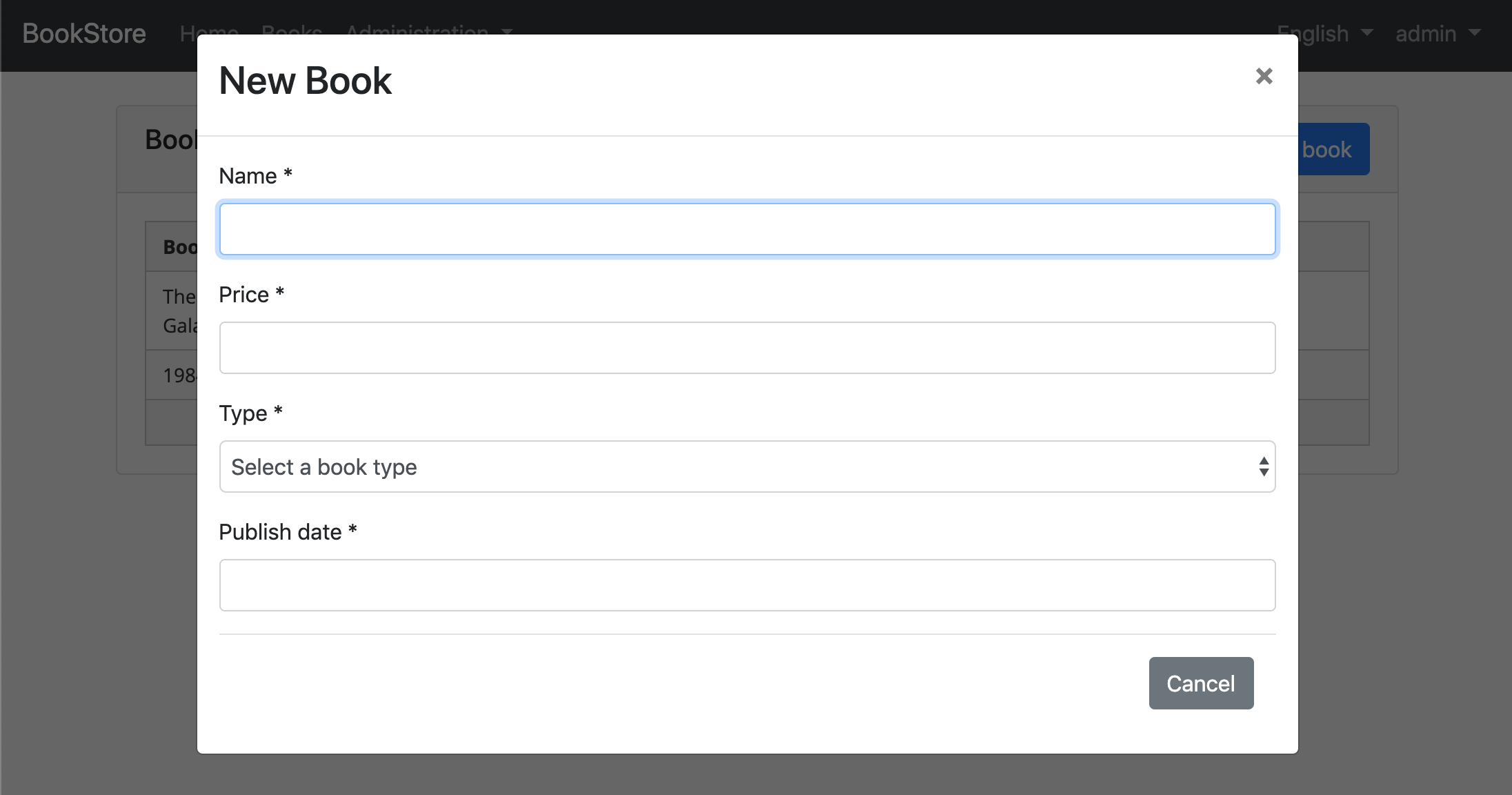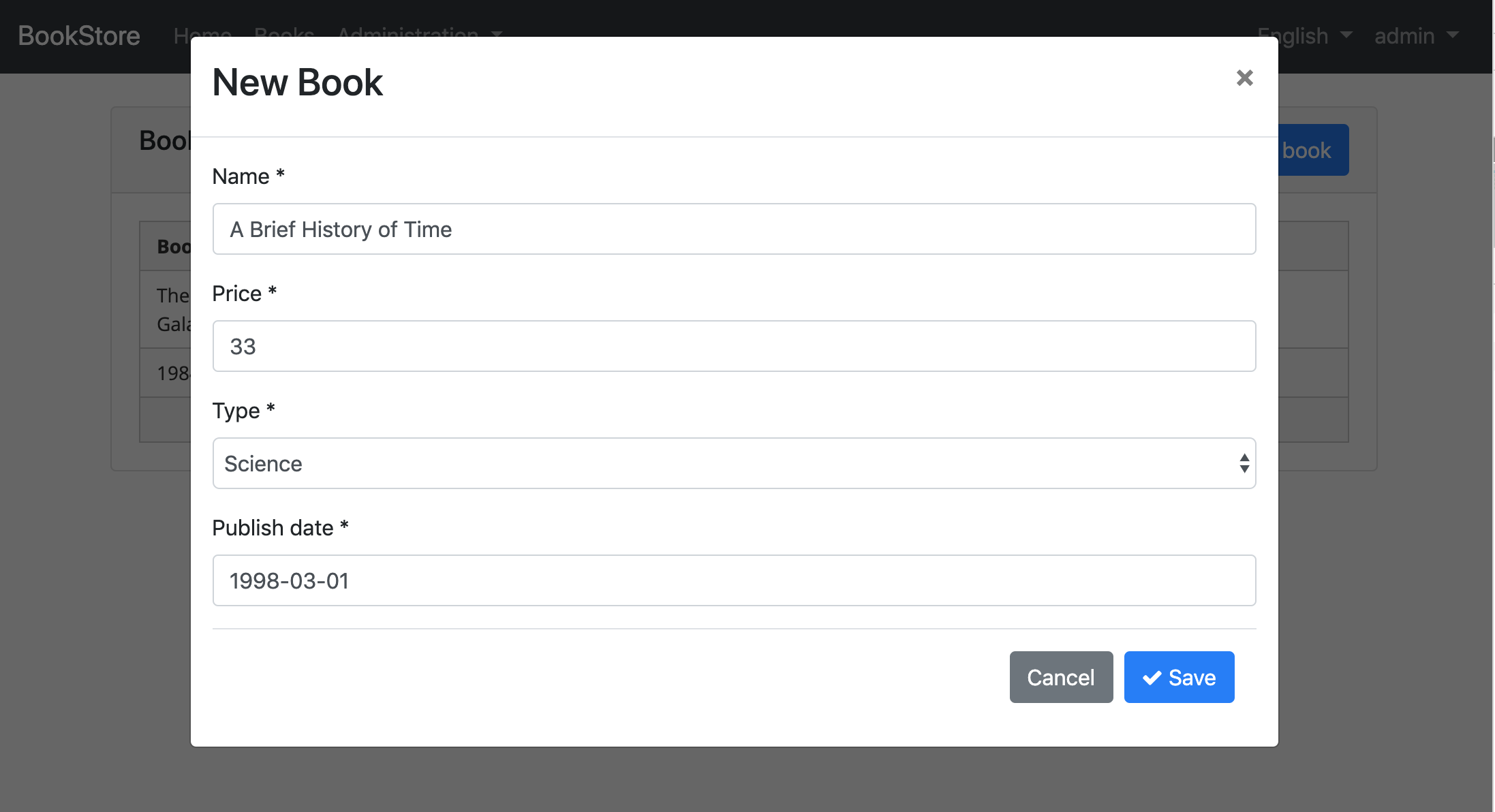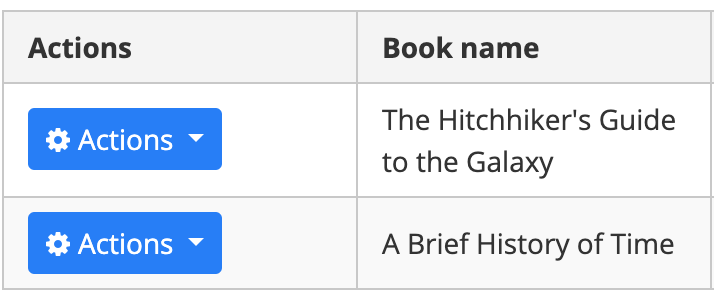15 KiB
Angular Tutorial - Part I
About this Tutorial
This is the second part of the Angular tutorial series. See all parts:
- Part I: Create the project and a book list page
- Part II: Create, Update and Delete books (this tutorial)
You can access to the source code of the application from the GitHub repository.
Type Definition
Create an interface, named CreateUpdateBookInput in the books.ts as shown below:
export namespace Books {
//...
export interface CreateUpdateBookInput {
name: string;
type: BookType;
publishDate: string;
price: number;
}
}
CreateUpdateBookInput interface matches the CreateUpdateBookDto in the backend.
Add HTTP POST Method
Open the books.service.ts and add a new method, named create to perform an HTTP POST request to the server:
create(body: Books.CreateUpdateBookInput): Observable<Books.Book> {
const request: Rest.Request<Books.CreateUpdateBookInput> = {
method: 'POST',
url: '/api/app/book',
body,
};
return this.rest.request<Books.CreateUpdateBookInput, Books.Book>(request);
}
State Definitions
Add the CreateUpdateBook action to books.actions.ts as shown below:
import { Books } from '../models';
export class CreateUpdateBook {
static readonly type = '[Books] Create Update Book';
constructor(public payload: Books.CreateUpdateBookInput) {}
}
Open books.state.ts and define the save method that will listen to a CreateUpdateBook action to create a book:
@Action(CreateUpdateBook)
save({ dispatch }: StateContext<Books.State>, { payload }: CreateUpdateBook) {
return this.booksService.create(payload).pipe(switchMap(() => dispatch(new GetBooks())));
}
When the SaveBook action dispached, the save method runs and then call create method of the BooksService. After, BooksService sends a POST request to the backend. When finished this HTTP call, BooksState dispatches GetBooks action for getting up-to-date books.
Add a Modal to BookListComponent
Open the book-list.component.html and add the abp-modal to show/hide the book form.
<abp-modal [(visible)]="isModalOpen">
<ng-template #abpHeader>
<h3>New Book</h3>
</ng-template>
<ng-template #abpBody> </ng-template>
<ng-template #abpFooter>
<button type="button" class="btn btn-secondary" #abpClose>
Cancel
</button>
</ng-template>
</abp-modal>
Then, add the New book button to show the modal.
<div class="row">
<div class="col col-md-6">
<h5 class="card-title">
Books
</h5>
</div>
<div class="text-right col col-md-6">
<button id="create-role" class="btn btn-primary" type="button" (click)="onAdd()">
<i class="fa fa-plus mr-1"></i> <span>New book</span>
</button>
</div>
</div>
Open book-list.component.ts and add the isModalOpen variable and onAdd method to show/hide the modal.
//...
loading = false;
isModalOpen = false;
// ...
ngOnInit() {
// ...
}
onAdd() {
this.isModalOpen = true;
}
Create a Reactive Form
Reactive forms provide a model-driven approach to handling form inputs whose values change over time.
Add the form variable and import to the FormGroup from @angular/core
//...
isModalOpen = false;
form: FormGroup;
Inject FormBuilder dependency by adding it to the BookListComponent constructor.
import { FormBuilder } from '@angular/forms';
//...
constructor(
//...
private fb: FormBuilder
) {}
The FormBuilder service provides convenient methods for generating controls. It reduces the amount of boilerplate needed to build complex forms.
Add the buildForm method for create book form.
buildForm() {
this.form = this.fb.group({
name: ['', Validators.required],
type: [null, Validators.required],
publishDate: [null, Validators.required],
price: [null, Validators.required],
});
}
- The
groupmethod ofFormBuildercreates aFormGroup. - Added
Validators.requiredstatic method that validation of form element.
Modify the onAdd method as shown below:
onAdd() {
this.buildForm();
this.isModalOpen = true;
}
Create the DOM Elements of the Form
Open book-list.component.html and add the form in the body template of the modal.
<ng-template #abpBody>
<form [formGroup]="form">
<div class="form-group">
<label for="book-name">Name</label><span> * </span>
<input type="text" id="book-name" class="form-control" formControlName="name" autofocus />
</div>
<div class="form-group">
<label for="book-price">Price</label><span> * </span>
<input type="number" id="book-price" class="form-control" formControlName="price" />
</div>
<div class="form-group">
<label for="book-type">Type</label><span> * </span>
<select class="form-control" id="book-type" formControlName="type">
<option [ngValue]="null">Select a book type</option>
<option [ngValue]="booksType[type]" *ngFor="let type of bookTypeArr"> {{ type }}</option>
</select>
</div>
<div class="form-group">
<label>Publish date</label><span> * </span>
<input
#datepicker="ngbDatepicker"
class="form-control"
name="datepicker"
formControlName="publishDate"
ngbDatepicker
(click)="datepicker.toggle()"
/>
</div>
</form>
</ng-template>
TODO: Add a short description.
We've used NgBootstrap datepicker in this component.
Open the book-list.component.ts and then add the bookTypes.
//...
form: FormGroup;
bookTypeArr = Object.keys(Books.BookType).filter(bookType => typeof this.booksType[bookType] === 'number');
The bookTypes variable added to generate array from BookType enum. The bookTypes equals like this:
['Adventure', 'Biography', 'Dystopia', 'Fantastic' ...]
Add the Datepicker Requirements
Import NgbDatepickerModule to the books.module.ts.
import { NgbDatepickerModule } from '@ng-bootstrap/ng-bootstrap';
@NgModule({
imports: [
// ...
NgbDatepickerModule,
],
})
export class BooksModule {}
Open the book-list.component.html and then add providers as shown below:
@Component({
// ...
styleUrls: ['./book-list.component.scss'],
providers: [{ provide: NgbDateAdapter, useClass: NgbDateNativeAdapter }],
})
export class BookListComponent implements OnInit {
// ...
The
NgbDateAdapterconvert Datepicker value type toDatetype. See the datepicker adapters for more details.
Create a New Book
Add the save method to BookListComponent
save() {
if (this.form.invalid) {
return;
}
this.store.dispatch(new CreateUpdateBook(this.form.value)).subscribe(() => {
this.isModalOpen = false;
this.form.reset();
});
}
TODO: description ??
Then, open the book-list.component.html and add the abp-button for the run save method.
<ng-template #abpFooter>
<button type="button" class="btn btn-secondary" #abpClose>
Cancel
</button>
<abp-button iconClass="fa fa-check" (click)="save()">Save</abp-button>
</ng-template>
Now, You can add a new book.
Add HTTP GET and PUT Methods
TODO: Description
Open the book.service.ts and then add the getById and update methods.
getById(id: string): Observable<Books.Book> {
const request: Rest.Request<null> = {
method: 'GET',
url: `/api/app/book/${id}`,
};
return this.rest.request<null, Books.Book>(request);
}
update(body: Books.CreateUpdateBookInput, id: string): Observable<Books.Book> {
const request: Rest.Request<Books.CreateUpdateBookInput> = {
method: 'PUT',
url: `/api/app/book/${id}`,
body,
};
return this.rest.request<Books.CreateUpdateBookInput, Books.Book>(request);
}
- Added the
getByIdmethod to get the editing book by performing an HTTP request to the related endpoint. - Added the
updatemethod to update a book with theidby performing an HTTP request to the related endpoint.
Update a Book
Inject BooksService dependency by adding it to the book-list.component.ts constructor and add variable named selectedBook.
selectedBook = {} as Books.Book;
constructor(
//...
private booksService: BooksService
)
- Added
booksServiceto get the detail of selected book byidbefore creating the form - Added
selectedBookvariable to reuse detail of selected book.
Modify the buildForm method to reuse the same form while editing a book.
buildForm() {
this.form = this.fb.group({
name: [this.selectedBook.name || '', Validators.required],
type: this.selectedBook.type || null,
publishDate: this.selectedBook.publishDate ? new Date(this.selectedBook.publishDate) : null,
price: this.selectedBook.price || null,
});
}
Add the onEdit method as shown below:
onEdit(id: string) {
this.booksService.getById(id).subscribe(book => {
this.selectedBook = book;
this.buildForm();
this.isModalOpen = true;
});
}
- Added
onEditmethod to get selected book detail, build form and then show the modal.
Add the selectedBook definition to onAdd method for reuse same form while adding a new book.
onAdd() {
this.selectedBook = {} as Books.Item;
//...
}
Add the this.selectedBook.id to CreateUpdateBook action in save method.
save() {
//...
this.store.dispatch(new CreateUpdateBook(this.form.value, this.selectedBook.id))
//...
}
Added the this.selectedBook.id property to reuse the CreateUpdateBook action.
Add "Actions" Dropdown to the Table
Open the book-list.component.html and add modify the p-table as shown below:
<p-table [value]="books$ | async" [loading]="loading" [paginator]="true" [rows]="10">
<ng-template pTemplate="header">
<tr>
<th>Actions</th>
<th>Book name</th>
<th>Book type</th>
<th>Publish date</th>
<th>Price</th>
</tr>
</ng-template>
<ng-template pTemplate="body" let-data>
<tr>
<td>
<div ngbDropdown class="d-inline-block">
<button
class="btn btn-primary btn-sm dropdown-toggle"
data-toggle="dropdown"
aria-haspopup="true"
ngbDropdownToggle
>
<i class="fa fa-cog mr-1"></i>Actions
</button>
<div ngbDropdownMenu>
<button ngbDropdownItem (click)="onEdit(data.id)">Edit</button>
</div>
</div>
</td>
<td>{{ data.name }}</td>
<td>{{ booksType[data.type] }}</td>
<td>{{ data.publishDate | date }}</td>
<td>{{ data.price }}</td>
</tr>
</ng-template>
</p-table>
>
Actions button added to each row of the table.
We've used to NgbDropdown for the dropdown menu of actions.
The Actions buttons looks like this:
Update the modal header for reuse the same modal.
<ng-template #abpHeader>
<h3>{{ (selectedBook.id ? 'Edit' : 'New Book') }}</h3>
</ng-template>
TODO: header ??
Open the books.actins.ts and add id parameter.
export class CreateUpdateBook {
static readonly type = '[Books] Create Update Book';
constructor(public payload: Books.CreateUpdateBookInput, public id?: string) {}
}
Added id parameter to reuse the BooksSave while updating and creating a book.
Open books.state.ts and then modify the save method as show below:
@Action(CreateUpdateBook)
save({ dispatch }: StateContext<Books.State>, { payload, id }: CreateUpdateBook) {
let request;
if (id) {
request = this.booksService.update(payload, id);
} else {
request = this.booksService.create(payload);
}
return request.pipe(switchMap(() => dispatch(new GetBooks())));
}
TODO: description & screenshot ??
Delete a Book
Open books.service.ts and the the delete method for delete a book with the id by performing an HTTP request to the related endpoint.
delete(id: string): Observable<null> {
const request: Rest.Request<null> = {
method: 'DELETE',
url: `/api/app/book/${id}`,
};
return this.rest.request<null, null>(request);
}
State Definitions
Add an action named BooksDelete to books.actions.ts
export class DeleteBook {
static readonly type = '[Books] Delete';
constructor(public id: string) {}
}
Then, open the books.state.ts and add the delete method that will listen to a CreateUpdateBook action to create a book
@Action(DeleteBook)
delete({ dispatch }: StateContext<Books.State>, { id }: DeleteBook) {
return this.booksService.delete(id).pipe(switchMap(() => dispatch(new GetBooks())));
}
TODO: description??
### Add a Delete Button
Open book-list.component.html and modify the ngbDropdownMenu for add the delete button as shown below:
<div ngbDropdownMenu>
...
<button ngbDropdownItem (click)="delete(data.id, data.name)">
Delete
</button>
</div>
### Open Confirmation Popup
Open book-list.component.ts and inject the ConfirmationService for show confirmation popup.
import { ConfirmationService } from '@abp/ng.theme.shared';
//...
constructor(
//...
private confirmationService: ConfirmationService
)
Add the following method to BookListComponent.
import { ConfirmationService, Toaster } from '@abp/ng.theme.shared';
//...
delete(id: string, name: string) {
this.confirmationService
.error(`${name} will be deleted. Do you confirm that?`, 'Are you sure?')
.subscribe(status => {
if (status === Toaster.Status.confirm) {
this.store.dispatch(new DeleteBook(id));
}
});
}
The delete method shows confirmation popup and listens to them. When close the popup, the subscribe block runs. If confirmed this popup, it will dispatch the DeleteBook action.




